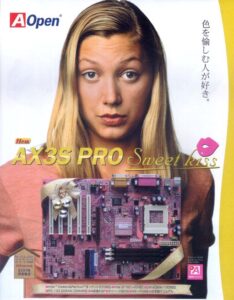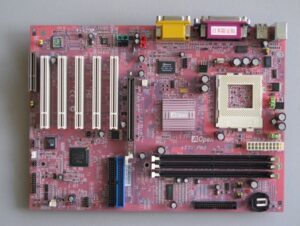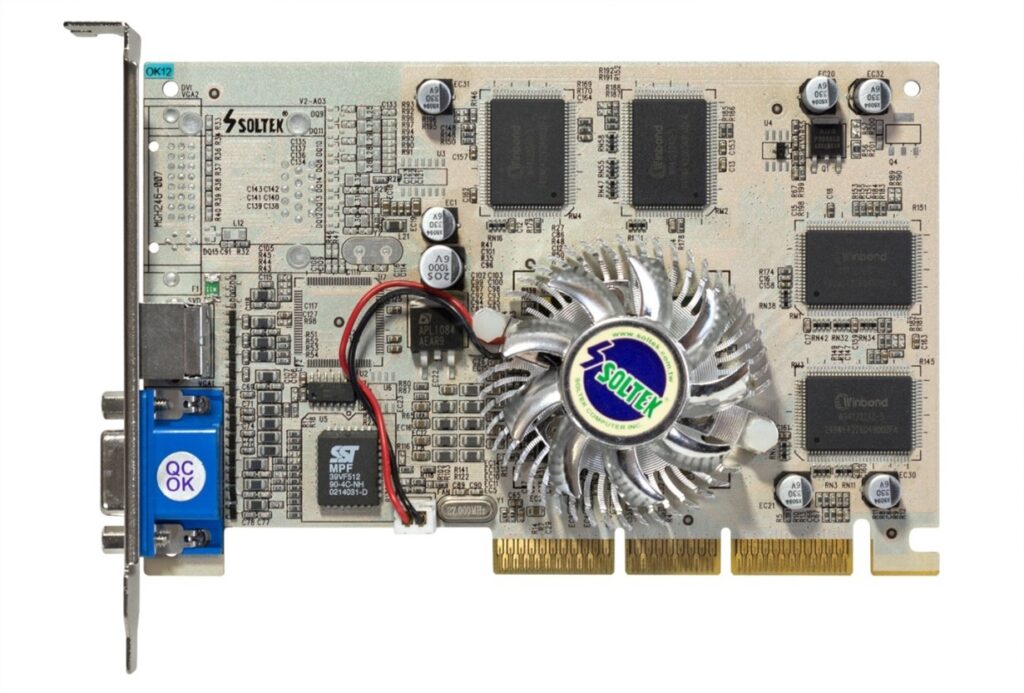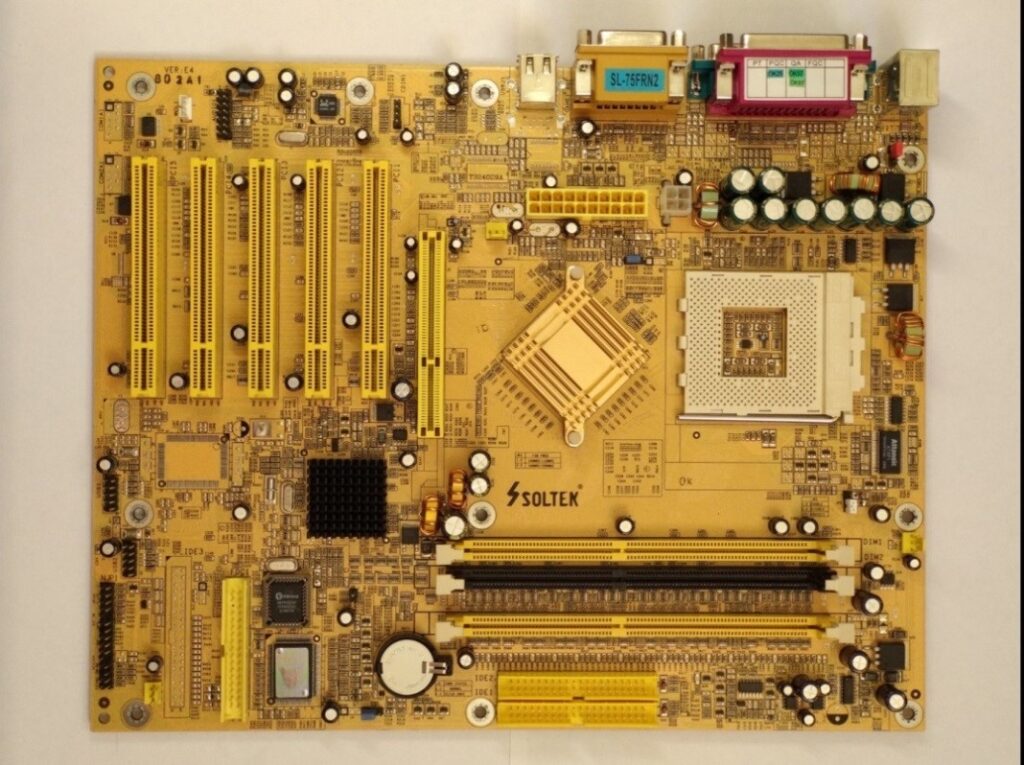Dead Brands of Computing Past: Soltek
 This is the beginning (hopefully) of a series of articles dedicated to dead brands – computer hardware manufacturing companies, which at one time enjoyed overwhelming success, but disappeared for one reason or another (some could not stand the competition, some were mired in corruption, some simply could not rebuild their own business). This first article will look at the story of the smashing success and unpredictable collapse of the Taiwanese MoBo manufacturer Soltek Computer Inc., one of the leading motherboard manufacturers in the early 2000s. (EDITOR: I Can’t wait for Abit – all hail the BP6)
This is the beginning (hopefully) of a series of articles dedicated to dead brands – computer hardware manufacturing companies, which at one time enjoyed overwhelming success, but disappeared for one reason or another (some could not stand the competition, some were mired in corruption, some simply could not rebuild their own business). This first article will look at the story of the smashing success and unpredictable collapse of the Taiwanese MoBo manufacturer Soltek Computer Inc., one of the leading motherboard manufacturers in the early 2000s. (EDITOR: I Can’t wait for Abit – all hail the BP6)
When you are a monopolist in the market of goods or services, then you are not afraid of any competition. But what if young, ambitious players, trying to surpass you, offer the market something that is not inferior in quality, but at the same time allows the consumer to save money? In such competitive conditions, you can either recapture positions, choosing innovative paths, or leave the pedestal. We saw similar races in the global IT market at the beginning of the twentieth century. Along with predatory companies in the unpredictable ocean of computer hardware, myriads of small manufacturers of computers and components multiply and multiply. And if someone does not manage to grow from a small fry into an adult fish, then this is a very common phenomenon. It is impossible to say that only fierce competition is the main cause of loss of profitability or absolute bankruptcy. The history of market relations knows many examples of how, due to negligent management, venerable brands burst like soap bubbles. There were cases when professional marketing was not enough to promote an innovative engineering idea. Often, the reasons for the collapse of brands were global economic and technical realities.
MoBo manufacturers specializing in the manufacture of motherboards, after the standardization of Intel microprocessors, popped up around the world like mushrooms after rain. In the mid-90s of the twentieth century, a personal computer still remained an individual assembly electronic device, and everyone could choose their own set of hardware, based on the needs for the functionality of the PC system. In the same period, it became absolutely clear that the IT technology market is an unplowed field. Go ahead, plant your own “seeds” and earn fast-growing profits. Thus, a relatively constant circle of microchip manufacturers gradually formed, which, with enviable regularity, introduced new products to the electronics market. By this time, the technology of surface mounting of printed circuit boards (the so-called SMT technology) was established, implemented using pick-and-place class robotic mechanisms. It has become the driving force behind the multilayer printed circuit board industry. Another important point in the rapid development of the IT market was the cultivation of young engineering personnel who offered not only innovative developments, but also the rapid implementation of competitive products. It goes without saying that the appearance in 1996 of a Taiwanese manufacturer – Soltek – did not make such a splash.
The new player boldly rushed into battle: the company’s production facilities were based on the use of the latest SMT equipment, and the staff consisted of the most talented personnel in the field of computer engineering. The head office of the company was located in Taiwan’s His-Chih Industrial District (Xizhi District). The area is known for being the headquarters of brands such as Acer and DFI. The company’s first assembly line was also located in the area. After two years of trademark paperwork and invention patents, the U.S. Patent and Trademark Office has registered the Soltek™ brand with ownership of Soltek Computer Inc. A trademark slogan was also registered: Soltek – The Soul Of Computer Technology. Main activities: computer technologies, software systems and products of research activities in the field of IT. But this is only a general nomenclature, while the detailed list of Soltek products was quite wide, from PC motherboards to keyboards and mice.
The products of the first production strategy are low-budget MoBo solutions based on VIA chip technologies, adapted for Intel and AMD processors. Consumer interest was captivated not only by the price of Soltek motherboards, but also by an extended set of interface capabilities of peripheral equipment, as well as a well-chosen set of utilities supplied in the kit.
The pioneer motherboard under the Soltek trademark was the SL-75KAV model, based on the VIA KT133A chipset. This MoBo successfully joined the competition with the leading similar device at that time –ABIT KT7A (both in quality and price). Based on this model, the SL-75DRV2 and SL-75DRV4 motherboards (VIA KT266A chipset), as well as the SL-75DRV5 model (VIA KT333 chipset) were further developed and released.
The consumer, in turn, gave preference to Soltek products not only because of the affordable price, but, above all, because of the uninterrupted and stable operation in super-heavy operating modes. So, even some difficulties with the configuration of Soltek motherboards did not stop PC builders from using them: while the manufacturer ABIT offered SoftMenu technology for assembly, the Taiwanese used traditional DIP switches.
A good marketing ploy, according to many experts, was not only a high-quality assembly and a price advantage, but also the design of motherboards. While all other MoBo-manufacturers continued to use PCB’s in the usual colors, Soltek offered the SL-75DRV4 board model in purple.
 This solution is presented in the product catalog under the name Purple Ray. The PR move not only worked, it took hold, and therefore, in the future, the colorization of motherboards became the hallmark of Soltek Computer Inc.
This solution is presented in the product catalog under the name Purple Ray. The PR move not only worked, it took hold, and therefore, in the future, the colorization of motherboards became the hallmark of Soltek Computer Inc.
After the appearance of top models of motherboards, the company did not stop looking for new know-how: constant upgrade of equipment, introduction of new technological solutions, constant adherence to the rules of competition (research of competitors’ developments, searching for their own innovative solutions in accordance with the requirements of the time). This is how Soltek’s advanced technology, VD-Tech, appeared. For the first time, this hardware solution was implemented in the SL-65JVB-X model, released in 2000.
A feature of VD-Tech was the voice diagnostics function. So, instead of the typical POST beep code system common in other models, a special chip gave the user voice commands if malfunctions were detected at the time of system boot. The technology “spoke” in two languages (English and Chinese), the messages contained information about the identified violations in the modular connection of the memory, video adapter or BIOS. A distinctive feature of Soltek brand motherboards with a special VD-Tech chip was the X ending, which was added to the serial name of the model. A year later, a new modification of the voice diagnostics of problems appeared – VD-Tech II. Voice commands have already been implemented here for six variants of typical problems.
Soltek, like a number of other competing manufacturers, paid special attention to improving the set of BIOS firmware functions in its own products. Although the company continued to work closely with the world’s leading BIOS chip manufacturers, Soltek engineers presented a couple of their own designs. In the future, innovative BIOS technologies only increased the brand’s importance in terms of overclocking. They developed their own solutions for automatic electronic security of computer systems. The first such auto-locking system was ABS (Anti-BurnShield) technology. So, Soltek ABS at the hardware level completely autonomously monitored temperature indicators and installed a power supply barrier in the case when there were signs of overheating of the device. In addition, Soltek BIOS has the function of optimal selection of voltage settings and frequency of the CPU and bus in overclocking mode. This innovation is called RedStorm. The combination of DIP switches and BIOS menu settings made it possible for Soltek motherboards to change the operating frequencies of electronic components with a step of 1 MHz, and the VCore voltage with a step of 0.025 V. Such fine-tuning gave a unique opportunity for overclocking fans to manually set any combination of frequencies and voltages. For those users who have not yet fully mastered the overclocking process, they offered a version of RedStorm with the selection of the required parameters in the OneTouch mode. These technologies allowed the Soltek brand to gain a foothold in the market of devices for enthusiasts.
In just three years (from 1999 to 2002), the company’s capital increased 2.5 times to 250 million US dollars. In 2002, a strategic restructuring of the company followed: official representative offices of the company were opened in the USA, the Netherlands, South Korea and Hong Kong (the United States was at that time the main market for products); also a course was taken to conquer the markets of Eastern Europe and South America. Directly in China, Soltek had organized several points of conveyor production of goods (in Taipei and in mainland China). The turnover of local production alone was up to 300,000 units of finished motherboards under the company’s brand. And even with such an abundance of products, Soltek surprised the market from time to time with its innovative innovations.
At the beginning of June 2002, at the Computex exhibition in Taipei, the company demonstrated its own modifications of the GeForce 4 MX440 and SIS Xabre 600 video cards, which stood out against the background of analogues in white and silver colors. Their colors matched perfectly with the same whitewashed Soltek Intel Pentium 4 motherboards, and in addition, these cards competed with Triplex, which was famous for its silver GeForce 4 and Xabre 400.
The video card could boast not only a unique color, but also the use of a high-quality element base. The color itself from a distance can be mistaken for white, but in fact, the coating has a bluish-pink range. Copper tracks under a white solder mask create a pink tint, and in those places where copper is etched, the color appears blue. (EDITOR: We take for granted these days the wide variety of PCB and connector colors, but this was all new territory back then)
 At the end of 2002, Soltek introduced motherboards of unusual color. Initially, it was planned to sell “exclusive” motherboards under the GoldenFlame brand. Soltek announced this in a press release regarding the release of the SL-85FR on the GraniteBay chipset. The SL-85FR was billed as “the world’s first gold-plated motherboard, which was to come in a gold-plated box and a gold-plated bag. The cables included with the board were also gold. However, later it was decided to release all nForceII boards under this brand.
At the end of 2002, Soltek introduced motherboards of unusual color. Initially, it was planned to sell “exclusive” motherboards under the GoldenFlame brand. Soltek announced this in a press release regarding the release of the SL-85FR on the GraniteBay chipset. The SL-85FR was billed as “the world’s first gold-plated motherboard, which was to come in a gold-plated box and a gold-plated bag. The cables included with the board were also gold. However, later it was decided to release all nForceII boards under this brand.
Introduced in May 2003, the company’s new series of motherboards and graphics cards was called VioletEyes. The products in this series had an unusual violet color.
 VioletEyes turned out to be the last series of Soltek motherboards with a different PCB color than black. As it turned out, the process of creating motherboards in bright colors is extremely toxic. And it did not meet the new environmental requirements. For this reason, all Soltek boards subsequently had a black PCB and purple expansion connectors, which were featured at VioletEyes.
VioletEyes turned out to be the last series of Soltek motherboards with a different PCB color than black. As it turned out, the process of creating motherboards in bright colors is extremely toxic. And it did not meet the new environmental requirements. For this reason, all Soltek boards subsequently had a black PCB and purple expansion connectors, which were featured at VioletEyes.
 Even with ‘boring’ black came a cool sounding name, the Black Thunder series. This is how the BlackThunder series of motherboards appeared.
Even with ‘boring’ black came a cool sounding name, the Black Thunder series. This is how the BlackThunder series of motherboards appeared.
Although Soltek has established itself as a MoBo-manufacturer of high-quality, reliable and inexpensive components for personal computer systems, the company’s analysts tirelessly continued to monitor the trends of the IT market. A particularly close look was directed towards ready-made systems, as many consumers began to give their preference not to individual assembly, but to a ready-made solution. Several models of the barebones system type were presented. For leadership in this market segment, Soltek had to compete with brands such as Shuttle and Supermicro. The company’s production facilities made it possible to outperform competitors in the shortest possible time with its line of barebone systems called QBIC. In addition to the successful architecture, spectacular design and attractive price, additional options were implemented in these PCs: from a set of proprietary software to a set of stylish accessories. The Computex 2004 exhibition for Soltek became a platform for the presentation of not only a rich set of different models of motherboards for the most relevant platforms, but also barebone personal computer systems.
How Soltek’s “golden flame” was extinguished.
In 2005, suddenly, for no reason at all, an official press release appears, voiced by the head of the public relations department of Soltek, in which it appears in black and white: the Taiwanese company Soltek Computer Inc. stops mass production of motherboards and focuses all resources on the production of computer peripherals. After such a statement, analysts of the global information technology market unanimously stated that this statement is a death sentence for the brand and the company as a whole. The perspicacity of the experts was confirmed literally in a matter of months: Soltek’s RMA service somehow lasted until the summer of 2007, after which the company’s official Internet resource stopped being updated, and there it stopped responding to a search query at all. After some time, official information about the status of Soltek™ appeared on the website of the American Patent Office: «Refuse to renew registration. The reason for the refusal is the lack of a response from the client.»
The first signs that Soltek stopped tossing firewood to maintain the “golden flame” appeared several years before the company’s official statement about the “change of course”. On May 13, 2003, SoltekUSA (a North American office headquartered in Seattle) issued a notice of termination of all operations in the United States. Although customers who had already purchased products under this brand in the States were still offered some kind of service at first, but with regard to the official reason for the curtailment of activities, the terminology was very lengthy. The press release listed the reasons that, according to experts, could not affect the economic stability of Soltek. Among the reasons mentioned: US military actions, general economic instability in the world and even bird flu (SARS epidemic), which “blew up” the entire People’s Republic of China.
The situation that befell Soltek is not an isolated case. True, some companies still managed to win back their “piece of the pie” by focusing on overclocking needs. Others tried to repeat Soltek’s experience in the production of motherboards of different colors.
 |
 |
AOpen AX3SPRO Sweet Kiss
Soltek’s “golden flame” gradually faded away. Reflections of it emerge only in the memory of computer fans, who at one time comprehended the magic of this unique and unforgettable “motley family”.
EDITOR: I surprisingly don’t recall using a Soltek board back in the day, though likely used a few for customers. Back then I used a lot of BioSTAR, Abit, and EPOX boards
Article written/adapted by Vlad. Edited by The CPU Shack












August 20th, 2023 at 5:46 am
I built quite a few soltek pcs, loved the purple board! Wondered what happened to them. Forgot about Abit and Aopen too!
August 21st, 2023 at 11:38 am
Killed my AXP 2500@3200 in a Soltek motherboard. Good days.
Then I put the Barton on a neckchain and met my future wife this way.
August 21st, 2023 at 12:24 pm
The best thing that could come from a dead Barton!
August 21st, 2023 at 1:35 pm
ABit BP6? VP6 was much better! ABit VP6 + 2xP-III 550 Coppermine, overclocked – my first true multicore workstation.
August 21st, 2023 at 2:29 pm
I built a VP6 system, but never had as good of stability with it as the old BP6, I ran 2x Celeron SL36C 366s at 500-550 in the BP6, with the high point RAID, a TNT2 + a a pair of Diamond Monster 3D IIs
September 3rd, 2023 at 5:07 am
I was a big fan of my Epox Optimus series EP-AD580 XR motherboard…had that one almost 2 years which was probably a record for me. Worked both with AMD Crossfire AND Nvidia SLI…good times.
March 4th, 2024 at 3:07 am
I had the SL-75DRV5 and used it for a long time. What I recall happened to Soltek is that they got caught up in the bad capacitor plague a few years later and it cost them a lot of money and reputation. They did honor RMAs; I helped someone I know get replacement caps for a bad “Golden Flame” board around 2004.
It actually hit the DRV5 at the end of its life. The early ones, like mine, were bulletproof, but the later ones had the bad caps. I never had a bad Soltek myself, but I did get a Leadtek board that blew up right before my eyes from leaky caps.